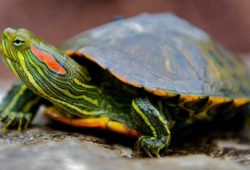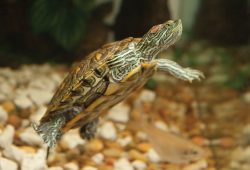Freshwater Turtles
In the article I share what I learned about Freshwater Turtles. Turtles, tortoises, and terrapins are all members of the super order of Chelonia and as such are classified as chelonians. Most people refer to the reptiles in this order as turtles, though there are differences between them.

Chelonians are characterized by the shell extending from their ribs, called a carapace. The carapace is comprised of bone or cartilage. Like other reptiles, turtles are cold-blooded, meaning they draw their warmth from their surroundings. Although some turtles are water-dwelling animals, they breathe air and lay their eggs on land. Aquatic turtles are the largest group, and live in both salt and fresh waters.
Types Of Freshwater Turtles
Freshwater turtles come in all sizes. The largest living turtle is the leatherback sea turtle, whose shell can reach a length of 6.6 feet and weigh as much as 2,000 pounds. The freshwater turtle is generally smaller, but several individuals of the Asian Softshell species have reached the 6.6 foot mark. The largest North American freshwater turtle, the Alligator Snapping turtle, can attain a shell length of 2.6 feet, whereas the Chicken turtle can reach a maximum length of 9.8 inches but usually averages between 3.9 and 5.9. There are several different types of freshwater turtle, many different species of which can be found in the southeastern United States. One of the most well-known of the species is the common snapping turtle.
Turtles, especially the smaller terrestrial and freshwater varieties, are very popular pets. Human exploitation has caused damaging declines in these populations, some so far as extinction. The state of Florida has enacted many laws protecting these animals from the over harvesting that threatens them due to their increasing popularity.
For instance, only one turtle can be taken per person per day, and only for non-commercial purposes. Some species are considered imperiled, and it is prohibited to hunt these species or any that closely resemble them. Furthermore, due to being carriers of salmellonosis, the FDA imposed regulations in 1975 against the sale of turtles under 4 inches long; it is illegal in every state to sell them. Despite all these laws governing the capture and sale of freshwater turtles, they remain very popular indoor pets.
The biggest problem in keeping a turtle is the maintenance of a healthy water quality. In the wild, the ponds these reptiles live in are infinitely larger than pet aquariums, and are much more naturally equipped for dealing with the natural waste turtles produce. It is always better to feed freshwater turtles in smaller, separate tub wherein they can eat and waste without polluting their home, and which can be cleaned after each use.



